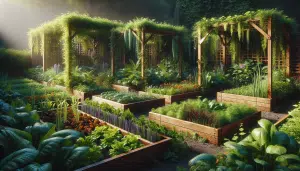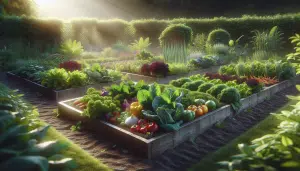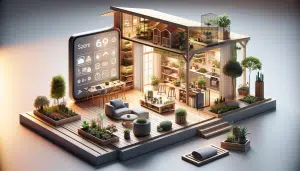Secrets to Growing an Indoor Herb Garden Fast
Lily Carter October 20, 2025
Unlock the delights of an indoor herb garden with practical tips that suit any home. Discover which herbs thrive indoors, care secrets, starter essentials, and design ideas to bring bursts of flavor and greenery into your living space.
Choosing Herbs That Thrive Indoors
Starting an indoor herb garden opens a world of possibilities. Selecting the right herbs is key to success. Popular kitchen herbs like basil, parsley, chives, mint, and oregano adapt well to life on a sunny windowsill or under grow lights. Herbs with compact growth habits and modest sunlight needs perform reliably. Hardy options such as thyme and sage bring robust flavors while requiring minimal care. For newcomers, choosing a combination of fast-growing herbs and classic favorites builds confidence and enjoyment.
Different herbs have unique characteristics and growth patterns. Basil thrives with warmth and consistent light, while parsley and chives prefer slightly cooler conditions but still need bright locations. Mint is famously resilient, adapting to varied environments and frequently rebounding after cutting. Understanding these preferences simplifies the growing process. Grouping herbs with similar water, light, and soil requirements supports healthy growth. This blend of practicality and experimentation is what makes an herb garden rewarding and personal.
Indoor herb gardens cater to every cooking routine. Some people prefer speedy growers they can snip in a week, while others enjoy nurturing slow-maturing varieties. A diversity of plant shapes and aromas creates both a visual and culinary feast. For those limited by light, grow lights expand possibilities: even less traditional options like cilantro or dill can be coaxed indoors. Selecting herbs based on household tastes and available light ensures a sustainable, productive kitchen garden throughout the year.
Understanding Light and Placement for Herbs
Light is an essential ingredient in the recipe for healthy indoor herbs. South-facing windows provide maximum sunlight. East or west-facing windows work if you rotate pots and check for stretching stems. Most culinary herbs crave at least six hours of sunlight daily for robust flavor and dense foliage. In dimmer homes, supplementing with energy-efficient LED or full-spectrum grow lights helps simulate sunny days. The right placement prevents spindly, pale growth and sets the foundation for a lush kitchen garden.
Not every home offers perfect light, yet herbs thrive if you adapt their placement. Try moving pots during the day to chase the sun or install adjustable shelves near bright windows. Herb gardens can flourish in kitchens, bathrooms, or living rooms. For herbs that prefer some shade, such as mint or chervil, indirect bright light creates satisfactory conditions. Monitoring leaf color and growth informs when it’s time to shift pots or add supplemental lighting. This small effort results in rewarding harvests year-round.
Grow light technology has made year-round indoor gardening practical for everyone. Many compact models blend easily with home décor. Adjustable height and intensity let you match the needs of various herbs as seasons change. Simple plug-and-play timers build a daily rhythm for your garden. For the best results, place grow lights 6–12 inches above herbs and adjust as plants mature. Balanced lighting means deeper color, consistent leaf growth, and a burst of fresh green on demand.
Soil, Pots, and Watering Tips for Success
The right soil sets the stage for vibrant herbs. Well-draining potting mix suited to edibles prevents soggy roots, supports steady growth, and retains enough moisture. Avoid garden soil, which compacts and hinders healthy root systems indoors. Amend mixes with a touch of perlite or sand for lighter aeration. Nutrient-rich but lightweight soils help herbs produce a constant flush of aromatic leaves. Explore organic potting blends if you want to grow pesticide-free kitchen herbs safely at home.
Container choice matters more than you might expect. Herbs in pots or window boxes with drainage holes avoid root rot—one of the main pitfalls for new indoor gardeners. Terracotta, ceramic, and plastic pots all work well if sized right for each herb’s mature size. Grouping smaller pots together helps maintain humidity. Use trays beneath to catch excess water and protect surfaces. Repotting as plants outgrow their containers keeps roots happy and ensures steady supplies of fresh herbs for every meal.
Watering herbs indoors is both an art and a science. Overwatering drowns roots, while letting soil dry too much stunts growth. A consistent routine—checking for dryness an inch below the surface—suits most herbs. Some, like rosemary or thyme, like drier conditions, while basil and parsley need a bit more moisture. Drain excess water freely to prevent mold. Observation is key; yellow leaves or wilting may indicate improper watering. Tuning your schedule pays off in lush, fragrant clippings each week.
Feeding, Trimming, and Maintaining Happy Herbs
Indoor herbs need feeding to maintain rapid growth and bold flavor. A balanced, water-soluble fertilizer designed for edibles gives plants a boost. Apply sparingly; overfeeding can lead to lush leaves but weak taste. Follow package directions or dilute further for delicate herbs. Organic feeding options, like liquid seaweed or compost tea, offer natural nutrition without chemical buildup. Regular, gentle feeding during active growth keeps herbs thriving, especially when harvested frequently.
Pruning is essential to bushy, productive plants. For basil and mint, pinch out growing tips to encourage side shoots. Remove older, yellowing leaves to keep the plant healthy. For woody herbs like thyme or sage, snip above leaf nodes to stimulate new branches. Trimming herbs helps prevent flowering, which can cause a bitter taste. Clean, sharp scissors or small shears prevent damage and reduce disease risk. Pruned herbs regrow quickly, so don’t be afraid to harvest often for cooking.
Preventing pests and diseases indoors requires observation. Most indoor herbs avoid major infestations, but spider mites or aphids can appear, especially in dry environments. Increase humidity, rinse leaves in the sink, or use insecticidal soap if needed. Good air circulation, regular leaf checks, and removing debris keep plants healthy. If a problem persists, isolate affected plants. With careful maintenance, indoor herb gardens offer a steady supply of fresh flavors, making every meal and cup of tea special.
Creative Indoor Herb Garden Designs and Placement Ideas
Designing an indoor herb garden merges function and aesthetics. Floating shelves in the kitchen or living room display trailing herbs like oregano and thyme. Tiered racks maximize vertical space, allowing you to showcase a medley of green. Custom arrangements—like grouping pots on a decorative tray—add structure and style. Hanging planters save counter space and add lushness. These design tactics encourage both visual beauty and convenient herb access, blending seamlessly with modern or rustic décor.
Repurposing items offers unique charm. Mason jars, teacups, or vintage tins transform into stylish herb planters with a touch of creativity. Wall-mounted planters near sunlit windows keep herbs within reach and make watering easy. Some people prefer compact countertop hydroponic systems, which use water instead of soil for fast, clean growth. Creative displays brighten indoor spaces, but practical considerations—easy watering, drainage, and sunlight—keep plants healthy and thriving.
For families or anyone seeking interactive decor, windowsill herb gardens invite participation. Kids enjoy planting and trimming, learning where their food comes from. Apartment dwellers can create vibrant vertical herb walls. For those with larger spaces, dedicated greenhouse cabinets or mini conservatories accommodate rare or specialty herbs. Themed gardens, like a pizza herb box or herbal tea bench, make indoor growing more personalized and fun. Customization ensures every home finds a perfect herb garden fit.
Troubleshooting Common Indoor Herb Garden Issues
Even with good care, challenges can arise. Common issues include yellow leaves, pests, or slow growth. Yellowing often signals overwatering or poor drainage. Trimming damaged leaves and adjusting water routines quickly revives plants. Fungal spots, caused by high humidity and poor air flow, can be managed by spacing pots and removing affected foliage. Herbs generally bounce back fast with simple interventions, providing year-round culinary value without much fuss.
If herbs appear leggy or dull, light is usually the culprit. Move pots closer to windows or increase grow light exposure. If stems stretch or leaves turn pale, act early for the best results. Herbs like basil and parsley need more light to maintain healthy color and compact shape. For pest outbreaks, isolate affected herbs and carefully inspect the rest of your garden. Natural treatments and vigilance keep most infestations under control, preserving both yield and peace of mind.
Root rot, while less common, can devastate indoor herbs. It typically results from soggy soil or pots lacking drainage. Discard compacted soil and replant in fresh, well-drained mix. Maintain consistent but moderate watering routines moving forward. For herbs that seem slow to recover, patience helps. Most herbs, if given the right conditions and occasional refresh, will rebound and thrive. Enjoy the vibrant scents, flavors, and happiness an indoor herb garden brings to any home, big or small.
References
1. The Spruce. (n.d.). How to grow herbs indoors. Retrieved from https://www.thespruce.com/how-to-grow-herbs-indoors-1402028
2. University of Maryland Extension. (n.d.). Indoor herb gardening. Retrieved from https://extension.umd.edu/resource/growing-herbs-indoors
3. PennState Extension. (n.d.). Growing an indoor herb garden. Retrieved from https://extension.psu.edu/growing-an-indoor-herb-garden
4. American Horticultural Society. (n.d.). Indoor herb gardens. Retrieved from https://ahsgardening.org/gardening-resources/gardening-articles/indoor-herb-gardens/
5. Royal Horticultural Society. (n.d.). How to grow herbs indoors. Retrieved from https://www.rhs.org.uk/herbs/growing-herbs-indoors
6. Better Homes & Gardens. (n.d.). Indoor herb garden ideas. Retrieved from https://www.bhg.com/gardening/houseplants/projects/indoor-herb-gardens/







